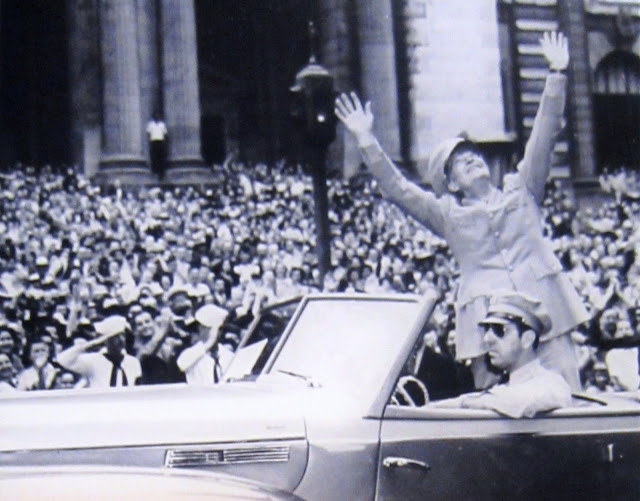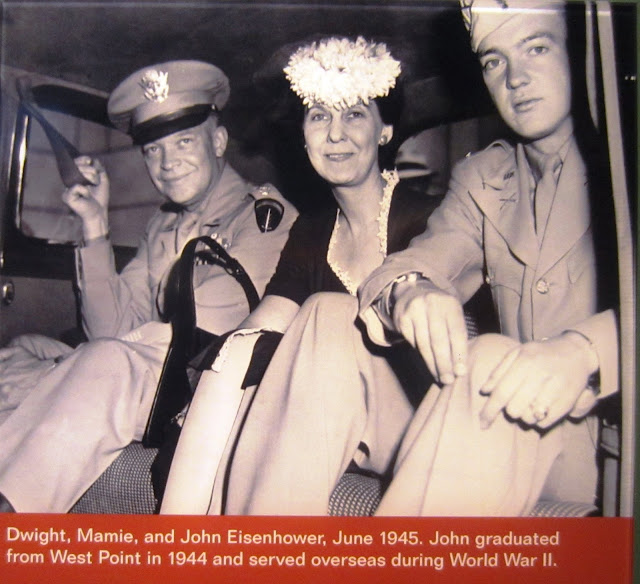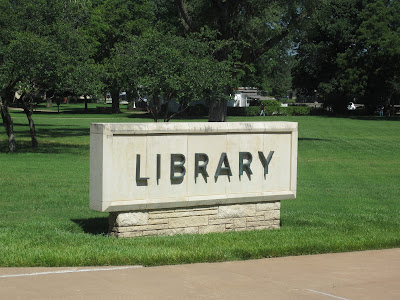After driving through Missouri, Iowa, and Nebraska, we headed for our fourth and last state: Kansas. During the next few days, our plan was to visit Abilene, Wamego, Topeka, Lawrence, and Kansas City (Kansas side):
(Wamego? What's in Wamego? You'll have to wait and see.)The first leg, from Lincoln, Nebraska, to Abilene, Kansas, was 165 miles of corn fields. Some people would call this a soothing drive; others might say it's mind-blowingly boring. By this point in the trip, I'd probably go with the latter except for the fact that we had a good audiobook going, so the drive was great.
Our first Kansas stop was the Dwight D. Eisenhower Presidential Library, Museum, and Boyhood Home in Abilene. Like the Herbert Hoover Presidential Library site we visited earlier in the trip, this is a sprawling park that obviously includes much more than just the museum. Those Midwesterners like their space.
1. EISENHOWER'S CHILDHOOD HOME
Eisenhower's family moved to Abilene from Texas in 1892 when Ike was two years old, and to this house in Abilene in 1898. Ike lived here with his five brothers and his parents until he left for West Point in 1911 at age 20. Ike's parents lived here until they died in 1942 and 1946.
When he was growing up, the home would have been surrounded by other houses, but they've all been razed to make room for this complex.
The house has many of its original furnishings:
View of the backyard:
While not a mansion like the ones the Teddy and Franklin Roosevelt grew up in, it certainly tops the Herbert Hoover homestead in West Branch, Iowa.2. THE EISENHOWER MUSEUM
The Presidential Museum, just down the sidewalk from the Boyhood Home, is a rather nondescript flat-roofed building:

The exhibits are almost all war-related. I would have liked more on Eisenhower's childhood, family, presidential campaigns, presidency, and post-presidency life. However, I get that Eisenhower was a war hero, and his war service permeated pretty much every aspect of his life.
There were some interesting war artifacts. For example, below is a "Mother's Cross," a piece of jewelry supposedly coveted by German mothers. The necklaces were given as awards for numbers of children born to Aryan mothers. The more children, the fancier the necklace. This one was for a woman with six or seven children:
In the United States, mothers were honored for sending their sons to war with flags they could hang in their windows. This mother had six children serving in the war, a star representing each child:
Having recently seen the movie The Imitation Game starring Benedict Cumberbatch, I was excited to see this German enigma machine on display:
A pair of Hermann Goring's wine glasses is nearby:
One of the ubiquitous Nazi armbands is on display:
This museum has a fixation on uniforms, which are sprinkled throughout the exhibits:
This plaque caught my eye because my mother had a German friend who had participated in Germany's assault on Russia. We tried to get him to talk about his experience once, but he would not go there. I don't know which city he fought in, and he has since died, but I know wherever he was must have been awful. I was stunned to see this statistic:
I paid attention to this timeline below because my mother's home city of Pforzheim was bombed by the RAF on February 23, 1945, killing almost 18,000 people and leveling about 80% of the city. It was one of the most devastating bombings of the war, but I never see it mentioned anywhere, probably because the bombing was carried out by the RAF and not the USAF. Maybe someday I can find something in a British museum.
The horrors of war were graphically addressed:
I have a thing for propaganda posters, and these two from Germany are especially dramatic. The translation of the top one is: "The eternal Jew: A documentary about world Jewry." The bottom one says: "Behind the enemy forces, the Jew."
I love this photo of American forces marching into Paris:
Different people who contributed to the war effort are highlighted:
When this 1942 Cadillac that drove Eisenhower around in Europe during the war and then in the United States after the war was retired from service in 1956, it had 200,000 miles on its speedometer and was on its third engine:
There are a few pictures and displays of the post-war celebration, including this iconic photo in 3-D:
Yeah, they need a chaperone:
At the end of the war, Ike and Mamie came home to Abilene on a train. If you are into trains, you can see the restored train depot and a scaled down version of the Eisenhowers' Pullman car not far from the Eisenhower Museum.
I'm digging Mamie's hat:
Somehow this photo of Eisenhower as a young boy is sandwiched in the middle of all these war photos. Hmmm.
That's Mamie's wedding dress in the picture above (upper right), and believe it or not, there is a piece of the Eisenhower's wedding cake on display. I'm guessing they had it freeze dried:
I always thought Mamie, with her too-short bangs and tightly curled hair, was a bit frumpy, but apparently she was considered one of the most fashionable women in the world in her day. She came from wealth and was used to having what she wanted, which included very expensive clothes:
The red placard in the photo below left says "Mamie Eisenhower, Style Icon" and notes that her favorite color was pink:
After a while, I began to feel the Mamie Love. She was a spunky lady.
Don't let Ike's Friendly Grandpa Face fool you. Remember he was the 1st Supreme Allied Commander in Europe during World War II. He would not have been easy to live with:
After the war, Ike was offered and accepted the presidency of Columbia University (1948-1953). He had graduated from West Point, but had been only an average student. During his time at Columbia he remained on active military duty and spent a lot of time going back and forth from New York to Washington, where he was also serving as a consultant to the Secretary of Defense and later as the informal chairman of the Joint Chiefs of Staff.
In addition to all his other titles, add "Bestselling Author":
You can also add "Juris Doctor" to that list as Columbia gave him an honorary law degree during the time he served as president of the university:
Eisenhower selected Richard Nixon as his running mate, and in spite of Nixon's lack of charisma and tendency to commit serious PR mistakes, they were quickly off and running full speed
It was a landslide win over Democrat Adlai Stevenson with the electoral vote coming in at 442 to 49:
 |
| Photo from Wikipedia |
The popular vote was a little closer at 55% to 44%.
The two terms of Eisenhower's Presidency (1953-1961) were marked by the growing popularity of television:
Increasing fears centered on the Soviet Union--leading to bomb shelters in family homes:
. . . growing Civil Rights issues, and Senator Joe McCarthy's Red scare:
In the picture below, the third man from the right is Ezra Taft Benson, Secretary of Agriculture and a member of the Twelve Apostles of the LDS Church (simultaneously):
Historian Stephen Ambrose said of Eisenhower: "He was the general who truly hated war, but who hated the Nazis more. He was the President who made a peace and kept the peace and thus provided the conditions that made it possible for the American people to exercise their right to pursue happiness."
 |
| Eisenhower and Khruschev |
The room of gifts from foreign countries is always fun:
How about this exquisitely carved ivory tusk? Not so politically correct these days. It was a gift from Ngo Dinh Diem, the first President of South Vietnam. He was later ousted and executed by the military.
Eight years of a Republican in the White House, however, ended when Democrat John F. Kennedy beat Eisenhower's VP, Richard Nixon, in a very close race.
3. THE GROUNDS OF THE EISENHOWER COMPLEX
Outside the museum is a nice statue of Eisenhower entitled Champion of Peace:
Across the lawn is another memorial:
Five bronze plaques extol the virtues of the Eisenhower family:
4. THE EISENHOWER LIBRARY
Another building houses the official Presidential Library (different from the Museum):
While this building is primarily a library and research center, there are also a few interesting displays, such as this cross-cut section of the "Eisenhower Tree":
This portrait of Eisenhower was a gift of the Serbian Chetniks:
Gene Autry, "America's Singing Cowboy," was a sergeant in the Army Air Corps and flew C-109 tankers. Some information at the museum said C-109s "could be as temperamental as a horse," which is possibly why Autry was given the assignment to fly them. He flew the dangerous route from India to China. Legend has it that he was the only pilot allowed to wear cowboy boots when he flew.
I had never linked Audrey Hepburn to World War II. I didn't know she was Dutch. The day after her 11th birthday the Nazis invaded the Netherlands, and she spent her adolescence under Nazi occupation. Information at museum states, "Audrey . . . suffered from malnutrition caused by war-induced shortages of food. Often her family was forced to eat grass and flour made from ground tulip bulbs.Audrey feared being abducted by the SS and being placed in the Nazi brothel system." When she got a little older, she worked in the Dutch underground. No wonder she was such a dedicated humanitarian all of her life.
5. THE EISENHOWER CHAPEL AND BURIAL SITE
Across from his boyhood home is a church-like structure called "The Place of Meditation," which was built when the museum complex was created.
Ike, Mamie, and their oldest child Doud Dwight, who succumbed to scarlet fever at age 3 1/2, are buried within this building.
Ike called Doud's death "the most shattering moment of [his and Mamie's] lives, one that almost destroyed their marriage."
Wildly patterned stained glass windows flood the room with brilliant light:
Behind the burial site is the "place of meditation" where Ike hoped "visitors would reflect upon the ideals that made this a great nation and pledge themselves again to continued loyalty to those ideals."
 Presidential Libraries and Museums do an excellent job of making men into heroes. Every time I visit one of these "shrines," I come away with feelings of pride and patriotism. I suppose it is important to remember that these museums are the Presidents' last opportunity to shape public perception of both themselves and their presidencies. The museums may give the appearance of presenting "all the important information," but they have to be very biased.
Presidential Libraries and Museums do an excellent job of making men into heroes. Every time I visit one of these "shrines," I come away with feelings of pride and patriotism. I suppose it is important to remember that these museums are the Presidents' last opportunity to shape public perception of both themselves and their presidencies. The museums may give the appearance of presenting "all the important information," but they have to be very biased.I just finished reading Eisenhower in War and Peace by Jean Edward Smith, a political science professor at Marshall University, professor emeritus at the University of Toronto, and a finalist for the 2002 Pulitzer Prize for Biography for his book on Ulysses S. Grant. My vision of Dwight Eisenhower by the end of the book was of a man who was much more complex than the powerful man presented in his museum. On one hand there was his meteoric rise through the military, his incredible successes as a military commander, and his immense popularity as the President of the United States. On the other hand there was his long-term affair with his British driver and what I consider his betrayal of Mamie, his poor leadership at Columbia, and many less that perfect decisions as President.
Was he a great man? Absolutely. Was he perfect? Far from it.









































































































Another incredible recap of a presidential museum. Eisenhowers, despite all of the war memorabilia, which you think would give it oomph, was one of my least favorite. Perhaps, as you surmise, because it just focuses on war and so little on anything else.
ReplyDeleteIt is a great day in Abilene!...because of Ike and Mamie.
ReplyDeleteIke's brother Milton looks a lot like a sister in that family portrait.
ReplyDeleteI was stunned, too, with the German assault on Russia statistic.
Did you know that Salt Lake Stamp Company used to make political buttons. Ned has a collection of buttons - including an "I like Ike" button.
ReplyDeleteInteresting how one event can so define a life.
ReplyDelete